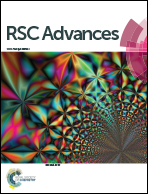Calixarene-functionalized graphene oxide composites fixed on glassy carbon electrodes for electrochemical detection
Abstract
Four composite materials were prepared by grafting calixarene derivatives onto the surfaces of graphene oxide (GO) via covalent functionalization to yield covalently functionalized graphene oxides (CFGOs). The resulting composites (CFGO-S4, CFGO-C4, CFGO-C6, and CFGO-C8) were fixed onto glassy carbon electrodes (GCEs) to investigate their electrochemical behavior. The modified GCEs were used in a three-electrode system for recognizing tryptophan (Trp), ascorbic acid (AA), and dopamine (DA). The oxygen-reduction reaction (ORR) and hydrogen evolution reaction (HER) were also carried out using the modified electrodes in order to explore their electrocatalytic properties. The results of electrochemical impedance spectroscopy (EIS) and static contact angle measurements confirmed that the CFGO composites were effectively adsorbed onto the surfaces of the GCEs. Cyclic voltammetry (CV) and differential pulse voltammetry (DPV) measurements showed that the CFGO composite/GCEs exhibited superior supramolecular recognition and consequently showed good electrochemical responses toward the target molecules. CFGO-S4/GCE could recognize dopamine perfectly, with a high current density of 8.82 mA mM−1 L cm−2 and a low detection limit of 0.25 μM.



 Please wait while we load your content...
Please wait while we load your content...